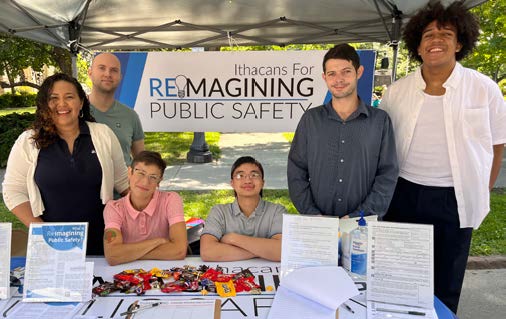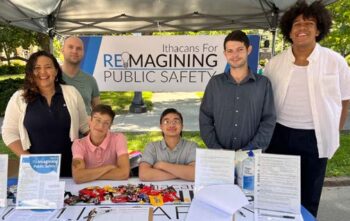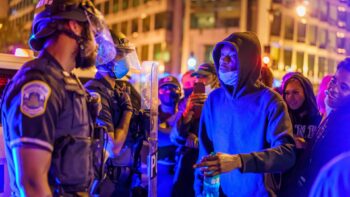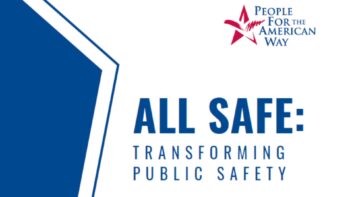
This fact sheet is part of People For the American Way’s new report All Safe: Transforming Public Safety. Here, we give an overview of one of the four prongs in our approach to reducing police violence: Restructuring the systems of public safety to ensure communities’ underlying safety and social needs are met.
Problem: There is an over-reliance on armed police officers to address a range of public safety issues, including mental health crises, student misbehavior in schools and low-level misdemeanors. The problem is exacerbated by increased militarization of police forces that results in physical harm and mistrust within communities, especially communities of color.
Solution: Transform policing and restructure public safety in a manner that appropriately delineates the role of police in society, deploys other resources to deal with social problems that do not require nor benefit from an armed police response, and demilitarizes the police. The Ithaca Public Safety Model provides a template. This model provides for the following:
- A new civilian-led department of public safety that oversees two co-equal divisions of armed and unarmed responders
- Training for all responders in de-escalation, alternatives to use of force, and mental health awareness
- Improved data and recordkeeping, as well as strengthened accountability and transparency measures
Key Facts
- Police violence disproportionately affects communities of color. In 2021, while Black people accounted for only 13 percent of the US population, 28 percent of the people killed by the police were Black. Another 19 percent were Latinx.
- Approximately 44 percent of Latino men and 50 percent of Black men can expect to be arrested at least once by age 23, while only 38 percent of White men can expect the same.
- Though they are disproportionately impacted by police killings, people of color are not the only victims of police violence. White people represent the majority of people killed by police.
- Since 2013, police officers in the United States have killed approximately 1,000 people every year. Many of these killings occurred following police responses to alleged misdemeanors or other minor infractions.
- Local officials can reduce police contact by eliminating low-level misdemeanors and citable offenses.
- Reevaluating the role police officers play in traffic enforcement is critical to reducing police violence.
- Of the estimated 240 million calls made to 911 each year, studies have found that 90 percent of calls involve situations that are nonviolent before police are called.
- Traditional police responses to mental health crises, combined with a lack of mental health services, have criminalized populations with mental health issues so that the largest inpatient psychiatric facilities in the US today are the Los Angeles County Jail, New York City’s Rikers Island, and Chicago’s Cook County Jail.
- Police are particularly likely to resort to violence in interactions with persons experiencing mental illness: 25 percent or more of fatal police encounters involve a person with a mental illness.
- Police officers in schools make students less safe, not more. Studies show that schools that add officers report no fewer incidents of violent, nonviolent, or property-related crimes than schools that remain officer-free.
- The paramilitary culture of police departments is exacerbated by the presence of military equipment, encourages problems to be “seen as acts of war,” and enables botched raids and excessive use of force.
- State and local law enforcement entities have access to “excess” military equipment—including armored trucks, body armor, assault rifles, tear gas, and other weapons—through the federal 1033 Program. Since its inception in 1997, the 1033 Program has channeled over $7.6 billion worth of equipment to more than 8,000 law enforcement agencies.
Learn More About Transforming Public Safety
|
|
|
|


